for the 2014 ECOF and Dum-Dum Conventions at:
www.ERBzine.com/dumdum
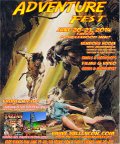


Official Edgar Rice Burroughs Tribute and Weekly Webzine Site Since 1996 ~ Over 10,000 Web Pages in Archive Presents Volume 4579 |

Eclectica Archive |

ECLECTICA v.2014.02 |
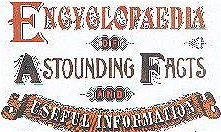
Eclectica Archive |
|
|
JUNGLE TALES OF TARZAN
A New Graphic AdaptationSequential Pulp Comics, a graphic novel imprint distributed by Dark Horse Comics, specializing in works of classic and pulp literature is proud to announce a new graphic novel based on Edgar Rice Burroughs’ classic novel, Jungle Tales of Tarzan.
The one hundred and forty four page graphic novel will be authorized by ERB, Inc. through Sequential Pulp’s distribution arrangement with Dark Horse Comics. The book will be designed as an anthology collecting the twelve loosely connected short stories written by Edgar Rice Burroughs chronicling the life of his most famous character, Tarzan of the Apes. All the events of the original work take place within chapter eleven of Tarzan of the Apes between Tarzan’s avenging of his ape foster mother’s death and his becoming the leader of his ape tribe. The original stories ran in Blue Book magazine from September 1916 through August 1917 prior to the book’s publication in 1919.
Writer Martin Powell will helm the graphic novel. Powell is well known for his work as the author of hundreds of science fiction, mystery, and horror stories. He has worked in the comic book industry since 1986, writing for Marvel, DC, Malibu, Caliber, Moonstone, and Disney, among others, and has been nominated for the coveted Eisner Award. He is also a respected and award winning author of children’s books, and frequently contributes prose for many short story anthologies. He resides in Saint Paul, MN.
Along with Powell, Sequential Pulp is bringing a veritable who’s who of exciting illustration talent. With an amazing cover and specialty art by Daren Bader to exciting story art by Pablo Marcos, Terry Beatty, Will Meugniot, Nik Poliwko, Antonio Romero Olmedo, Mark Wheatley, Diana Leto, Steven E. Gordon, Lowell Isaac, Tom Floyd and Jamie Chase. The Introduction is by Robin Maxwell (author of Jane: The Woman Who Loved Tarzan). Each story has been matched up with an artist whose passion and love for Burroughs’ Tarzan and specifically for the story selected will go a long way towards making this one highly anticipated book in the Tarzan canon.
Each story will run twelve pages in length and the book will be in full color. Sequential Pulp is planning a standard trade paperback and a very limited signature deluxe signed edition.
|
|
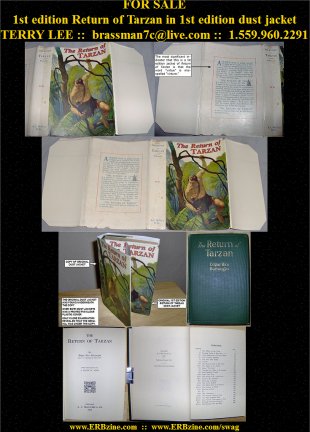
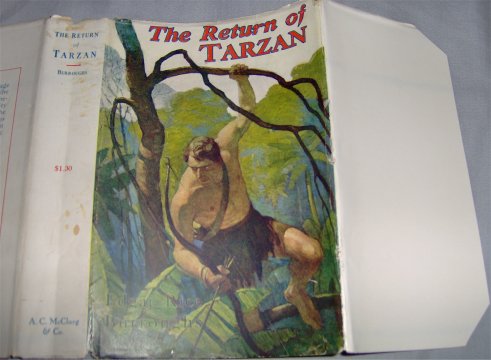
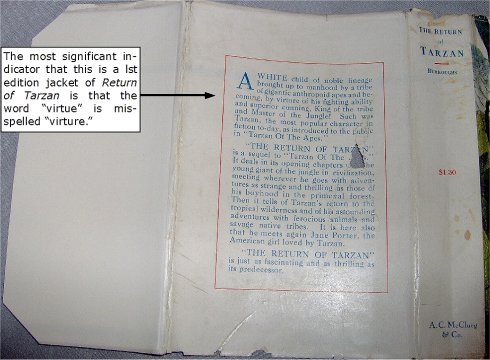
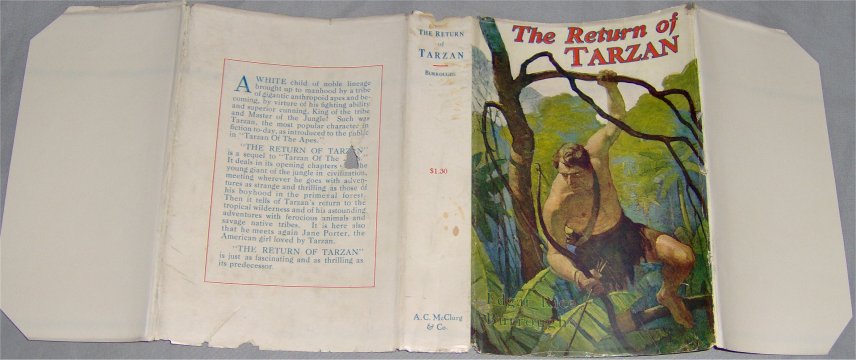
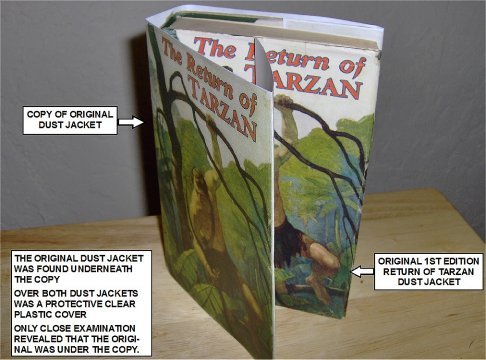
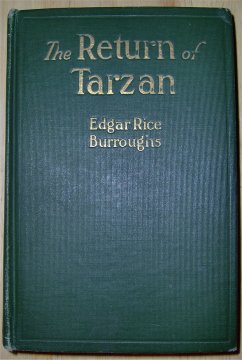
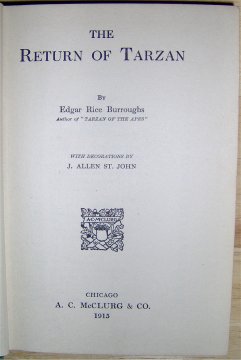
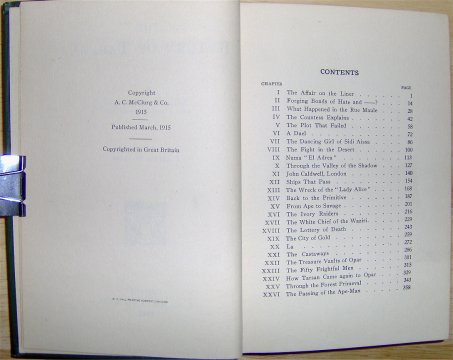
ERB INSCRIPTIONS
Tarzan of the Apes. Chicago: A. C. McClurg & Co., 1914. First edition, first issue (with no "acorn" device on the spine, and with the W. F. Hall imprint in Old English on the copyright page).
Inscribed by Burroughs on the front free endpaper (which is loose):"To Henry Studley Burroughs/and his good wife, Ella/Frances Odhams, from/their low-brow brother,with/a bunch of love/Edgar Rice Burroughs". Elsewhere in this book is a printed (silver gelatin) image of Tarzan and a group of apes mourning the death of an ape, signed by Burroughs' nephew (and frequent illustrator) Studley Oldham Burroughs ("S O Burroughs") affixed to the blank page facing page 1. Also with the bookplate of Ella Oldham Burroughs (Edgar Rice Burroughs' sister-in-law and Studley's mother) on the front pastedown.
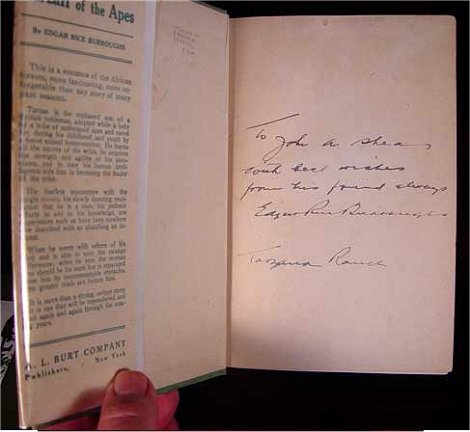
|
"To John A. Shea, with best wishes from his friend always, Edgar Rice Burroughs, Tarzana Ranch" |
|
|
ERB's Personal Library www.ERBzine.com/dan Inscriptions
The Illustrated Online Bibliography of all the ERB Titles
|
|
|
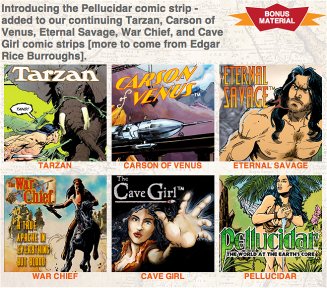
From the ERBzine FaceBook Group
Join us at:
www.facebook.com/groups/ERBzine
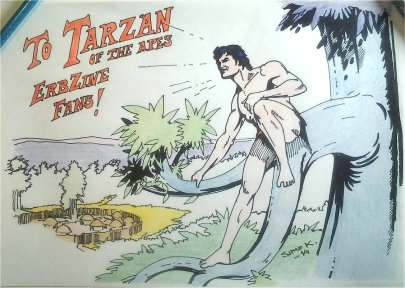
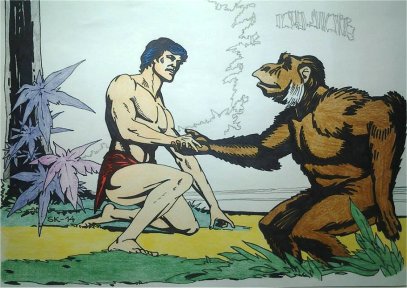
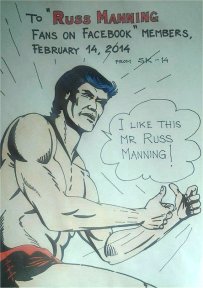
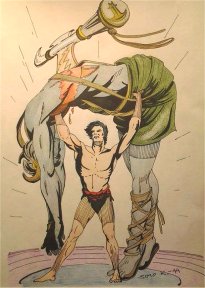
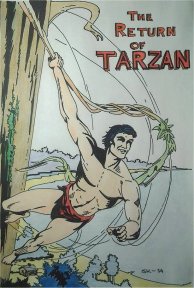
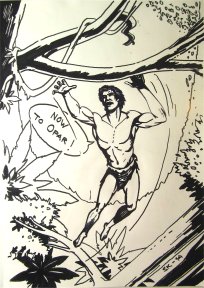
TARZAN ART
by
Simo Karjalainen
![]()
|
Ricardo Delgado's blog |
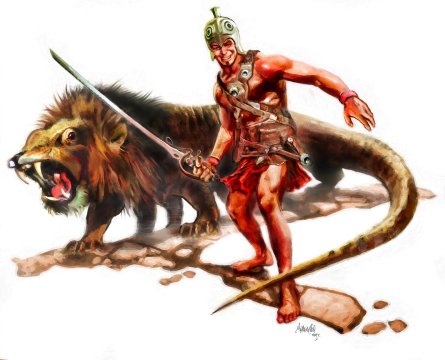
John Carter and Banth |
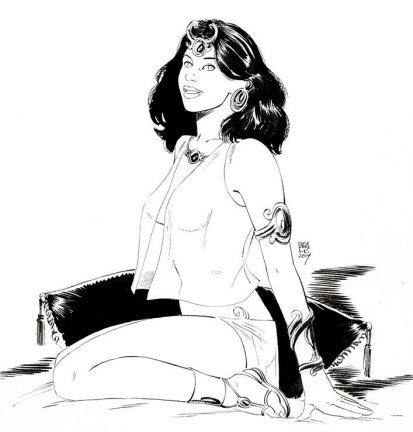
Barsoom Girl by Louis Paradis |
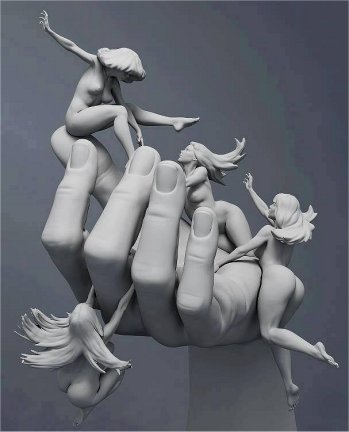 |
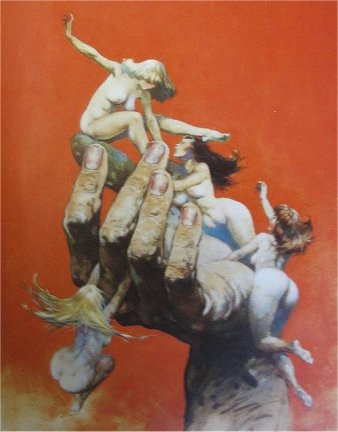 |

The most stunningly gorgeous adventure comic strip of all time finally returns in its definitive edition, the first to boast superb restored artwork that captures every delicate line and chromatic nuance of Foster’s original masterpiece. |
|
the first two years of the Prince Valiant run. www.ERBzine.com/mag42/4201.html and www.ERBzine.com/mag42/4201a.html |
Edgar Rice Burroughs’s The Mucker
by Ron Marz and Lee Moder
is now featured as one of the latest in ERB, Inc.'s line-up of
colour graphic adaptations of ERB's books.
The new strip is available exclusively online at
EdgarRiceBurroughs.com/comicsFrom the creator of Tarzan of the Apes and John Carter of Mars, The Mucker is a story about the exploits of Burroughs’ only anti-hero – Billy Byrne, a brash and brawling street tough from Chicago’s West Side – grounded in the harsh realities of life in the slums of the early 1900’s. Decades before Indiana Jones uncovered the Lost Ark and Rambo fought his personal guerrilla wars, the ruthless Mucker would find himself on whatever side of the law suited his savage nature, taking on crooked fight promoters, brutal gangsters, sinister kidnappers, ferocious headhunters and a femme fatale or two.
This new strip many others can be purchased, along with other comics, as part of a $1.99 per month subscription to the official Edgar Rice Burroughs Digital Comic Strips service. The service currently features numerous all-new adventure strips based on classic Burroughs stories including Tarzan, Pellucidar, The Eternal Savage, The Land that Time Forgot and Carson of Venus.
“Hardcore Burroughs fans consider The Mucker one of his best works,” said Marz. “Adapting these novels gives me a chance to expose a great story to an audience who might not be familiar with it. . . . I grew up on the work of Edgar Rice Burroughs and, to a large extent, I’m the kind of writer I am because of Edgar Rice Burroughs,” said Marz, who does a regular commentary track-style interview at ComicBook.com in support of his Top Cow series Witchblade. “I’m following not only in his footsteps, but in those of so many other creators who have left their mark on these concepts and characters. My job is to make these stories worthy for existing fans and completely accessible for new fans.”
|
|
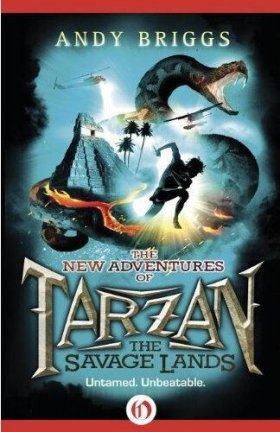
The Worlds of Edgar Rice Burroughs
Edited by Mike Resnick and Robert T. Garcia
Cover Artist: Dave Seeley
sfrevu.com ~ Oct 1, 2013 ~ Review by Nick SauerThe Worlds of Edgar Rice Burroughs is a collection of eleven stories by modern authors set in the various fantastic worlds created by the early twentieth century master of the adventure story. The title is no exaggeration as every one of Burroughs's series, including some of his later and lesser known ones, are represented in this volume. As a result, there is certainly something for fans of any of Burroughs's writings to be found in this volume.
With Tarzan being Burroughs's most successful character, it is hardly surprising that three of the stories feature him. While I'm not a huge Tarzan fan myself, I have read enough of the books to get a reasonable grasp of the character and feel that all of the authors successfully captured his personality. "Tarzan and the Great War" has him dealing with espionage in Algeria and "Tarzan and the Martian Invaders" is an alternate universe story as these invaders are clearly not of the Barsoomian variety. "Tarzan and the Land That Time Forgot" takes him to the world more commonly known as Caprona. This last story is an indirect sequel to Tarzan at the Earth's Core and was my favorite of the three.
Pellucidar was my favorite of Burroughs's fantasy realms so I was pleased to see two stories set within this hollow Earth world. Ironically, both feature Pellucidar's geo-stationary moon somewhat prominently. Mercedes Lackey introduces us to a resident of that moon who has fallen to the inner world. While I love Pellucidar it is fraught with scientific problems, F. Paul Wilson takes on the herculean task of trying to address some of these in his entry and manages to solve about half of them. He specifically addresses the mystery of Pellucidar's moon in a very clever manner that had never occurred to me during all of these years.
Tragically, there is only one story set on Barsoom due, apparently, to the licensing agreement involved with the recent film. It is a reprint of an earlier published and hard to find story by Mike Resnick. Making up for this are a number of stories set on the rest of Burroughs's fantasy series. "Scorpion Men of Venus" is a story set on Amtor (Venus) by well known Burrough's biographer Richard A. Lupoff. Towards the end of his life, Burroughs began what would have probably become a new series set on the distant planet of Poloda. Only one of the two stories was published during Burroughs's lifetime with the second being released posthumously so, it was especially pleasing to see Todd McCaffrey contribute a new piece to this series. Also, in the lesser known of Burroughs's worlds is a trilogy that takes place in the future and set on the Pellucidar-like hollow moon which the natives refer to as Va-nah. Set after the events of the first novel, and contemporary with events described in the first chapter of the second, Peter David contributes a story which uniquely centers on a female character in the form of Nah-ee-lah the moon maid.
Burroughs also did a couple of short non-fantasy series. One featured the infant of a pioneer couple who was adopted by the chief of the Apache tribe who killed his parents. He would go on to become the great Apache warrior Shoz-Dijiji (Black Bear) in a couple of novels. Ralph Roberts continues the adventures of the Black Bear in his entry in the anthology. "Apache Lawman" features a healthy dose of action and, while I very much enjoyed the story, I would have preferred a few more pages worth of setting and character development to make the pacing better match the original novels. The other series is called the Mucker which is an antiquated term that today would be synonymous with thug or hooligan. Billy Byrne is this mucker who undergoes a huge transformation after being shanghaied in San Fransisco. Max Allen Collins and Mathew Clemens contribute a story that takes place immediately after the conclusion of the first book in the series but adds a bit more closure to the novel's somewhat abrupt ending.
I also want to make a special mention of the cover art on the book which features John Carter and Dejah Thoris as I feel it is one of the best representations of both characters I have ever seen done by an artist. I was pleasantly surprised at how close this picture came to capturing how I imagined the characters in my mind's eye back when I first read A Princess of Mars all those years ago.
Picking my favorite stories of the volume is really an exercise in choosing my favorite type of chocolate as I found all of the stories highly entertaining and enjoyable. If I had to choose I would say that "Tarzan and the Land That Time Forgot", "To the Nearest Planet", "The Forgotten Sea of Mars", and "Moon Maid Over Manhattan" were my favorites in no specific order.
For those unfamiliar with Burroughs's writing I'm not certain how effective this volume would be as an introduction to his many fantastic worlds. I felt all of the authors definitely captured his style of writing while putting some of their own unique spins on it but, being familiar with a good share of his work, it is somewhat difficult for me to say which stories would require less foreknowledge of the original material for a new reader to truly appreciate them. "Apache Lawman" would most likely work as the characters are well introduced and the story is a bit of a new beginning for Black Bear himself. Even passing familiarity with Tarzan should make both "Tarzan and the Martian Invaders" and "Tarzan and the Land That Time Forgot" accessible. To a lesser extent the Barsoom and Amtor based stories might work as well.
It is my sincere hope that this volume is successful enough to be the first of many such anthologies. In the wishful thinking department I'll briefly mention what I would like to see in future volumes. More stories set on Barsoom would be appreciated which may, hopefully, be more likely given that the current licensee seems to have abandoned the property. Further stories in the Poloda series would be a godsend. The Amtor story is readily set up for a sequel and F. Paul Wilson could potentially answer the rest of Pellucidar's scientific mysteries in a further story set in that world. While those are my preferences any new stories set in the highly imaginative worlds of Edgar Rice Burroughs would be more than welcome.
|
|
Hustle and Prose: Edgar Rice Burroughs There are many ways in which the world has changed in the last century: polio vaccinations, personal computers, removal of anti-miscegenation laws, the new iterations of the endless generational cycle of boy bands required to soothe the Old Ones in their slumber. But perhaps one of the most indicative of how the world has shifted, particularly in the labor market and in publishing, is that people used to write books to make money as a last resort. People like Edgar Rice Burroughs.
The Toast.net ~ September 10, 2013
Previous installments in this series can be found here.
http://the-toast.net/2013/09/10/edgar-rice-burroughs/Before he began writing fiction, Burroughs had: worked as an instructor of geology, cavalry, and Gatling gun at a military academy; joined the army and chased after outlaws; been honorably discharged from the army for a heart murmur; owned a stationery store in Pocatello, Idaho; worked on a ranch with his brothers; worked at the American Battery Company with his father (for whom, as an advertisement, he drove the world’s first electric car through the Columbian Expo in Chicago in 1893); mined for gold along the Snake River; worked as a railroad policeman, construction company timekeeper, accountant, and clerical manager; sold light bulbs to janitors, candy to drugstores, and bound volumes of lectures door-to-door; served as office manager for a company that made a snake-oil “cure” for alcoholism that the FDA briskly shuttered; wrote and sold pamphlets on expert salesmanship; managed the stenography department at Sears, Roebuck; and sold pencil sharpeners. At one point, he applied to join both the Rough Riders and the Chinese army (he was rejected on both counts). When checking his pencil sharpener company’s ads in pulp fiction magazines, Burroughs read some of the work and, as he put it later, he figured, “if people are paid for writing such rot … I can write something just as rotten.” That’s a bit of clever branding-in-retrospect; in reality, he’d been writing on the side for a while for his brother’s kids (and to distract himself from his professional difficulties).
Regardless of his origin story, Burroughs’s first foray into professional storytelling was “Under the Moons of Mars,” serialized over six months in 1912 in pulp magazine The All-Story. “Under the Moons of Mars” is what we now know as “A Princess of Mars,” which Disney presented as John Carter last year, to the delight of literally dozens of us. They can be fun to read in large part because literally nothing bad can happen.
Yeah, John Carter gets into fights regularly with “the worthiest foe” he has ever faced (he’s prone to hyperbole), but he’s always going to win. Friends that we thought were killed in battle will show up later to save the day. The love interests will always end up together. Gore Vidal nailed it, I think, in his 1967 article for Esquire, in which he argues that Tarzan and John Carter are “daydream figures” for bored adults; avatars for the “dreamer [that] ceases to be an employee of I.B.M. and becomes a handsome demigod moving through splendid palaces, saving maidens from monsters (or monsters from maidens: this is a jaded time).” Indeed it is, Gore.
Burroughs received an impressive $400 for the serialization of “Under the Moons of Mars” (adjusted for inflation, that’s nearly $9,500 today), and by the time the “Moons” serialization was complete, he had written another two novels, including Tarzan of the Apes. And thus begins Burroughs’s golden period of hustling.
Despite Rudyard Kipling’s probably-not-far-off-the-mark comment that Burroughs wrote Tarzan of the Apes just to “find out how bad a book he could write and get away with it,” Tarzan earned Burroughs $700 in initial serialization and was an immediate cultural sensation. Imagine if we had all read Harry Potter and the Philosopher’s Stone as soon as it came out in 1997 and were clamoring for The Chamber of Secrets in 1998 the same way we actually were when The Deathly Hallows came out in 2007.
Even though he was new to the publishing and magazine industry, Burroughs’s history in sales primed him to do it right. By the time the third Tarzan book, The Beasts of Tarzan, was ready to be serialized, Burroughs was playing the editors at The All-Story and New Story magazines off each other to drive up his per-word payment; he ended up selling it for $2,000. In the summer of 1913 alone, Burroughs’s income was $4,600 in story sales and $6,000 in syndication commissions. On top of the serialization and book sales, movie rights soon came in, too.
The first Tarzan film came out in 1918, and even though the initial film stuck to the plot of the book, subsequent films spun further into the grunty, “Me Tarzan, you Jane” caveman schlock that most casual viewers associate with the character. Burroughs intensely disliked this, as his Tarzan was a multi-lingual member of the House of Lords. But the movies further expanded the audience for his books, and afforded him the ability to start living in the style to which he hoped to become accustomed (read: he was constantly running out of money).
With his history of slick salesmanship and job-jumping, Burroughs knew a good opportunity when he saw it, and he grabbed on tight to the growing Tarzan empire. Over the years, he published more than two dozen Tarzan books, but it is his control over his content, rather than the content itself, that is remarkable.
Burroughs incorporated himself in 1923 (he’s not a businessman, he’s a business, man), the first American writer to do so, and by 1931 had cut out the middleman and was self-publishing his Barsoom and Tarzan sequels, as well as his many other series and one-off genre pieces, though nearly everything was still serialized in the pulps first. Incorporating lowered his income taxes (Dame Agatha should have thought of that), and crucially, he also retained licensing, if not always creative, control of non-book usage of his characters, including the Tarzan films, the syndicated Tarzan comic strip, radio show, and comic books. And all this income made it possible for him to make some big investments—we have Burroughs to thank for the Tarzana neighborhood in Los Angeles, which grew up around his ranch of the same name. Here, perhaps, it is worth noting that in Burroughs’s made-up ape language, “tarzan” means white-skinned, which may have been appropriate for the character, but was a little on-the-nose for a whites-only planned community.
His female characters aren’t typically shrieking or helpless, and occasionally they even fight alongside their male counterparts, but largely they serve as motivation or reward for the male heroes. However, it wasn’t his depictions of women, I think, that got him in the most trouble—it was his particularly virulent take on masculinity. His main characters are typically super-athletic, fish-out-of-water fighters who are loners (except for a handful of trusted friends and advisors). They are most comfortable when nearly naked (it sure is hot in this jungle/on Mars/on Venus/in the center of the Earth/on this undiscovered volcano crater-continent) and armed with a blade, and they are devoted to demonstrating chivalry through actions, not words, like some effeminate courtier.
This vision of manliness was perfect for the generalist pulp magazines, but it eventually backfired on Burroughs. He wanted to branch out as a writer, but his readers didn’t want histories or romances or melodramas—they just wanted their manly, “clean-limbed” men. Burroughs wanted badly to be like Jack London (hence the ranch), and to transcend from “genre fiction” into “literary fiction,” but, to his lifelong chagrin, it wasn’t to be. One evening, when he and his second wife were on their honeymoon in Hawaii, Ernest Hemingway and his new wife Martha Gellhorn happened to be at the same restaurant. Florence, Burroughs’s wife, saw Hemingway across the room, and encouraged Burroughs to go introduce himself. Embarrassed by her fangirling and perhaps his own stature in the literary world compared to Hemingway’s, Burroughs refused, preferring to sit and stew. Hemingway and Gellhorn left without even knowing the Burroughses were there.As seen in that non-encounter with Papa, Burroughs brought some of his misery upon himself. But there were plenty of external stressors, as well—for example, the Depression wasn’t great for pulp writers (or anyone, I guess). The magazines had less and less money to pay for serialization, and the “popular” editions, precursors to paperbacks today, of Burroughs’s books sold for just fifty cents apiece, of which he got five cents. However, once Burroughs, ever the hustler, decided to cut out the middlemen and publish his books himself, contracting with warehouses and distributors through Edgar Rice Burroughs, Incorporated, his profits started to go back up. He explained his process thoroughly in the May, 1937, edition of Writer’s Digest; it’s still worth a read for any aspiring self-publisher.
In addition to the media endeavors, ERB, Inc., also licensed Tarzan bread, Tarzan ice cream cups, Tarzan clay action figures, and even the Tarzan Clans of America network, modeled on the Boy Scouts. Marketing experts warned that flooding the market with too much Tarzan would create internal competition, but, in a rare sound business decision, Burroughs was right—more Tarzan just created a demand for even more Tarzan.
Burroughs continued to write, and rake in the cash money, and, after enjoying his honeymoon there, spent some time living in Hawaii. A witness to the bombing of Pearl Harbor, he became the country’s oldest war correspondent at the time, writing, among other things, a morale-boosting column called “Laugh It Off.” It took until his mid-sixties, but he finally got to see some of the front-line action that he’d be writing about for more than half his life.
After the war, Burroughs moved back to Encino, California, where he died in 1950. Per his wishes, his ashes were buried at the foot of a walnut tree outside of his Tarzana offices—the final request of a man dedicated to his work. Burroughs left behind two ex-wives and five children (three biological from his first marriage, and two stepchildren he adopted after his second marriage).
There’s always a chance you could do something big.
Burroughs went from pawning his wife’s jewelry to buy ginger snaps for lunch to owning a 550-acre chunk of Los Angeles within a decade. Don’t throw in the towel just yet.You don’t have to be good at everything.
Gore Vidal asserted in his Esquire article that while “Burroughs is innocent of literature and cannot reproduce human speech, he does have a gift very few writers of any kind possess: he can describe action vividly.” And that’s Vidal speaking as a fan—way harsh, Tai. But he was onto something: you don’t have to be a perfect writer. You just have to be an interesting writer. If someone in your workshop group just really nails dialogue every time and you just can’t take dealing with their effortless talent any more, remember that they maybe feel the same way about you and setting.Self-publishing is not what it used to be/is what it used to be.
Self-publishing is no longer relegated to the land of vanity presses and print-on-demand copies of retiree memoirs, which Amazon is eager to remind authors of on a regular basis. But that “old” version of self-publishing isn’t the whole story; when the publishing industry was still coalescing into the behemoth we know it as today, authors like Edgar Rice Burroughs and Mark Twain would self-publish their work to have better access to the sales and control of the content. Self-publishing is absolutely a legit path—just be sure to read the fine print so you understand what percentages you’ll be handing over and what choices you’ll actually have control over.Rework your content.
Most of us will never be in the position of managing a pan-media brand like Tarzan, which is good, because that sounds exhausting. But we can practice that sort of content herding on a much smaller level. Say, for example, you’re going to participate in NaNoWriMo in November, and you have your basic characters nailed down and a general outline. You won’t start on the novel itself until November, but in the next couple months, you could sketch a couple comics or write a short film script that deals with the same characters and/or setting—this would give you a new view of your novel, and potentially material that you can reuse.Or, directly from the man himself, from an article in The Writer’s Monthly: “Don’t get the idea that you’re through with a basic plot when you’ve written one story from it…keep it and sprout another—or three or four. It’s easy!” Like the sourdough starter school of writing.
Works Referenced:
A People’s Guide to Los Angeles
Esquire
Edgar Rice Burroughs, The “Barsoom” Series (Indiebound | Amazon)
Edgar Rice Burroughs, The “Tarzan” Series (Indiebound <—OMG, what is up with that cover illustration | Amazon)
Edgar Rice Burroughs, The “Caspak” Series (Indiebound | Amazon)
John Taliaferro, Tarzan Forever : The Life of Edgar Rice Burroughs, Creator of Tarzan (Indiebound | Amazon)
|
|
Edgar Rice Burroughs’ Tarzan:
The Complete Russ Manning Newspaper Strips
Volume One: 1967-1969
$49.99, 288 pages
Comics Journal ~ Sep 12, 2013Has time passed Tarzan by? Does he have any cultural cache left in the 21st century? Note: I’m not debating the aesthetic merits of the various films, comics, or original novels by Edgar Rice Burroughs (which I admittedly have not read), but whether or not the character himself still has any hold on the public imagination the way he did 80, 50, or even 20 years ago. I suspect the answer is “not,” for the simple reason that the Lord of the Jungle just carries too much baggage with him. Africa is no longer regarded as a place of wonder, mystery, and danger where ant-men and other weird beasties might dwell, but as a continent full of famine, civil war, and other strife brought about by decades of imperialism and colonialism. Burroughs created Tarzan during an age of American expansion (in the Philippines and Cuba, for example), when the notion of the “White Man’s Burden” was still regarded as a noble calling (Kipling’s poem was published in 1899; the first Tarzan novel was published in 1912), and there’s simply no getting around the awkward racial and cultural issues that cling to him in contemporary eyes. My suspicion is that the 1999 Disney movie will turn out to be his swan song.
But it’s not as though people weren’t aware of the problems surrounding everyone’s favorite loincloth-wearing lad in years past. Take for, example, cartoonist Russ Manning, who took over the Tarzan newspaper strip in 1967, not exactly a year devoid of cultural upheaval.
Russ Manning took over the strip with two intentions: 1) Move away from the “Me Tarzan, You Jane” reductionism of the Johnny Weissmuller movies and hew closer to Burroughs’ original novels, and 2) Make the character more appealing to a more modern and perhaps cynical readership or at least offer an apologia of sorts.That second goal is made obvious by a storyline in Volume One of IDW/Library of American Comics’ new Tarzan Vol. 1 which collects the first two years or so of Manning’s run. At one point, Tarzan and his family, who live on a rather palatial ranch in deepest Africa, are attacked by a band of would-be freedom fighters. The leader is a Che Guevara-type, beard and all, who claims to want to “liberate the savages” he accuses Tarzan of exploiting. Of course, it eventually turns out he’s a ruthless, cutthroat, treasure-hungry thug, neatly turning the voice of anti-imperialism into that of a vile oppressor.
Before we discover his true colors, however, we get to see him make a speech to the African tribe Tarzan “rules” over (Tarzan seems to have a rather laissez-faire attitude towards governing). He promises these “savages” to free them from Tarzan’s enslavement and bring them machines that will help them build great cities. Their response? Thanks, but no thanks, we prefer Tarzan. Because, for all the trappings of imperialism he’s seems to be bedecked with, he ultimately understands their way of life better than this left-wing interloper.
To his credit, Manning takes great pains to avoid offensive racial and ethic stereotypes. His Africans aren’t reduced to playing porters and pounding jungle drums but are portrayed as noble, intelligent, and if not equal to Tarzan, at least fierce, proud warriors in their own right. Manning obviously spent a good deal of time researching the dress, customs, and environment of sub-Saharan cultures and it shows frequently in the strip.
Indeed, if there’s anyone in Manning’s strip that comes off really badly, it’s Jane, Tarzan’s wife. I don’t know how she’s portrayed in Burroughs’ novels, but she’s little more than a cipher here, a pretty face that constantly needs rescuing from various monsters and evildoers and seems completely incapable of rescuing herself or really doing anything beyond looking pretty and worrying a lot. She’s the ultimate damsel in distress.
In fact, I found myself wondering how Jane feels about being constantly left on the sidelines while her husband and teenage son, Korak, go off on wondrous and extremely dangerous adventures. At one point, she becomes slightly horrified watching her family cavort with apes in a practice known as “dum-dum” (draw your own racial allusions) and wonders if she can ever truly understand them. No wonder that the Sunday sequences end with Jane leaving a “Dear John” letter for Tarzan saying she’s had it with the jungle and is going back home to England. Who can blame her?
It’s a shame considering the number of more interesting or at least better realized female supporting characters that pop up in the strip from time to time. True, most of them are villains or at least have ignoble motives (the bulk of them just want to get into Tarzan’s pants, such as they are) but at least their sexual aggressiveness is a welcome change from the mousy blandness of Jane.
There’s a disturbing sexual current that runs through Manning’s strips, especially in one storyline where Jane is kidnapped by a group of creepy, bird-like “winged men.” It is extremely clear that they intend to rape Jane and impregnate her. Manning makes this as explicit as possible without actually using the r-word or having any torn clothing. “If they are like roosters, the winner will claim the hen. I’ve got to get away,” Jane tells herself. If that didn’t telegraph the subtext loud and clear, there’s the cavern of kidnapped women Jane comes across that have already given birth to a generation of winged men. I credit Manning for being willing to push the envelope a bit in a family newspaper, but there’s no denying that for any 21st century reader with even the slightest understanding of the horrors of sexual violence, this storyline leaves a creepy after taste.
There are other bits too that suggest a weird, sexist undercurrent: A savage tribe of giant, well-tanned, women that like to munch on a tiny, mouse-sized race of people; a young female adventurer who’s constantly showing up her whiny, emasculated suitor but still needs lots of saving from Tarzan (she later dons a racy costume of ostrich feathers when her clothes get ripped off [don’t ask] making her look like a burlesque performer. I don’t know if Manning is simply aping Burroughs or indulging in his own fetishes, but it’s all a bit odd to put it mildly.
Despite all of this, there’s no denying Manning’s capability, not just as an artist but also as a storyteller. His crisp, dynamic art excels in the best Alex Raymond/Burne Hogarth tradition and his panels are full of a lean, muscular Tarzan leaping and gallivanting through the jungle and toward the reader. He’s excellent at pacing the strip, especially given the minimal amount of space he was given (usually only three panels a day), some of which had to be occasionally be given to exposition or recapping the past adventure. Drawn as it was in an age that was moving away from photorealistic soap opera and adventure strips, it’s hard not to view Manning’s Tarzan as something of a middle finger to newspaper editors, a sign that not everything on the funnies page needed to be drawn on the level of Miss Peach, dwindling space be damned.
There is something charming about the fantastical elements that Manning and Burroughs draw upon in Tarzan. It’s hard not to smile or be at least a little thrilled when the so-called Lord of the Jungle crosses a raging river riding a triceratops, fends off his village from a rampaging tyrannosaurus, or just leaps across a wide ravine. At the same time, Manning’s hard work is brought down by the character’s essence and the racial and cultural overtones that surround him. As good as Manning’s work is, Tarzan feels more like a cultural artifact than a thriving, vibrant character. Certainly those who have an affinity for the sort of pulp adventures Manning and Burroughs indulged in will able to enjoy this even while acknowledging some of the more unpleasant aspects of the work. And those readers looking to simply marvel at Manning’s artistic talents will find plenty of pretty pictures to gaze upon. For some, that’s enough. Others might well read it and wince.
Online responses to the above article
Bill Hillman says:
“. . . original novels by Edgar Rice Burroughs (which I admittedly have not read)” ???
I suggest you read the books written by Edgar Rice Burroughs. Many inaccuracies in your article. Heavy criticism and misunderstanding of ERB and his characters make it clear that you have very little understanding of the author and his influence on countless authors, SF themes, scientists, astronauts, conservationists, etc.
Bill Hillman
Editor and Webmaster for the
Edgar Rice Burroughs Tribute Websites and Weekly Webzines
www.ERBzine.com ~ www.tarzan.com ~ www.tarzan.org
Ö H says:
It’s hyper-sensitive politically correct denouncements of innocuous titles like Manning’s Tarzan from uninformed hipster critics in articles such as this that perpetuate lower expectations from the buying public and are killing the comics industry. I can’t wait for volume 2.
VC says:
Absolutely agree with O H…Me too! Can’t wait to get hold of the three remaining volumes! And I just got hold of two Korak and the gorgeous Sunday strip Tarzan collection immortalised by Russ Manning… My daughter sent the books from the US and my wife ferried them across the skies to India, just an hour ago! And I’m happy to announce/brag that I have the Manning originals too, which I bought as a kid growing up in Bombay (Not just Tarzan but Magnus too in mint condition) Needless to add I became an instant fan of this absolutely fabulous comic character all thanks to the genius of the folks who put their creations out with minimal fanfare. And they set standards so high so effortlessly that only when they stopped we realised how irreplaceable they were! That is why I am buying these classics all over again, not just as a Tarzan or Manning groupie but as a writer and illustrator who has worked for some of the world’s biggest newspapers and magazines for the last 30 years!
Leo says:
I absolutely agree, too, with OH. Particularly irritating the specious words about Jane and the winged men: instead of be pleased with the capacity of Manning in telling about real life-like themes…
JG says:
I think Tarzan in his many incarnations still has a lot to thrill the modern reader. Manning’s art still looks beautiful. As for Jane not being well realised,it is difficult to do this within the confines of a newspaper strip. Even Tarzan does not show any of the layers of complexity he has in the ERB books- this just isn’t possible when people only get a few panels a day. These strips should just be enjoyed as a visual feast. For the time he was writing his novels, Burroughs shows a lot of progressive ideas and I am sure that if he was alive now he would write in a style which was more suited to our era and how we perceive different cultures. Tarzan is an extremely iconic character and like Superman, Batman and James Bond, he just needs someone with imagination who is in tune with the essence of the character to update him effectively. Burroughs books are filled with optimism, a faith in the human spirit, perception of human nature and a joyful appreciation of the world and the many promises it holds. Even though our views about Africa has changed, there is still room for heroism, mystery and adventure. Overall, I felt that the review was actually reasonably balanced but Tarzan is a force of nature and should not be written off yet.
JB says:
Somebody ought to approach the Burroughs and Manning estates about novelizing Russ Manning’s stories. A series of books a la John Eric Holmes “Mahars Of Pellucidar”. My favorite stories are “Jungle Revolution”, “Sacred Lake/Squid God”, “Valley Of Insects,/Return To Opar”… It’d be very cool to read them as novels.
DG says:
I collect all things about Tarzan and R M. I organised a meetting teen years ago about Tarzan in the city to Becherel in FRANCE.
Also, I study the story in the comix. So.RM is the best drawer of Tarzan !
PH says:
“Russ Manning is the best drawer of Tarzan” . . . ?
Maybe, except that Burne Hogarth and Joe Kubert also drew Tarzan, and spectacularly so. RM is clean, efficient and competent; Hogarth and Kubert are superior in every way.
PC says:
As Derek The Badman says above, Marsh was the man. His Tarzan stuff was so uniquely gentle and patient and observant, unlike any others’ work. No idea if it’s faithful to the novels, but I don’t care. Hogarth’s drawing was beautiful but also anatomically and gesturally histrionic. Manning is lovely as well, but his sci-fi stuff was better. Steve Rude really draws upon Manning’s style, much much more than the more often mentioned Kirby or Toth. I see almost zero Kirby in Rude’s work. Maybe 85% Manning, 10% Toth, 5% Kirby, with the backgrounds and secondary characters being maybe 35% Seuss. Would be interesting to see a well written Tarzan tale drawn by Rude.
|
|
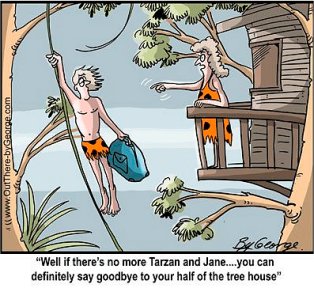
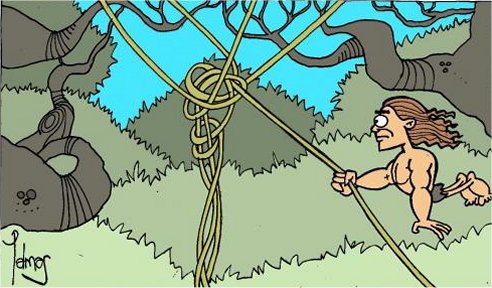
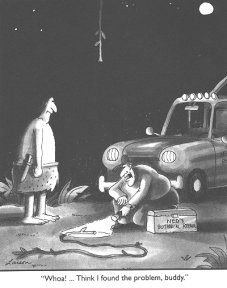
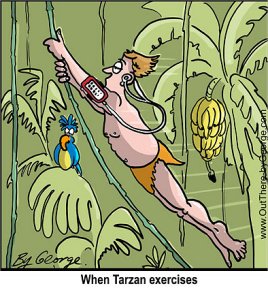
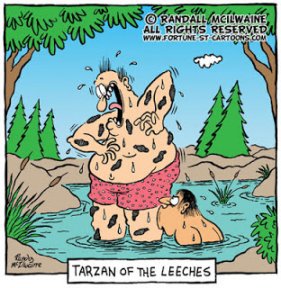
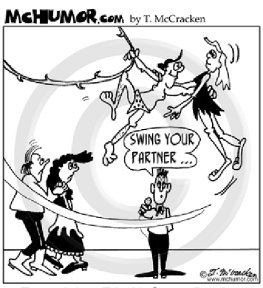
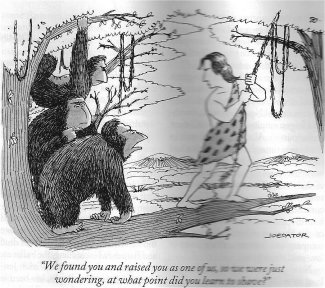
![]()
![]()

![]()

BILL
HILLMAN
Visit
our thousands of other sites at:
BILL
AND SUE-ON HILLMAN ECLECTIC STUDIO
All
ERB Images© and Tarzan® are Copyright ERB, Inc.- All Rights Reserved.
All
Original Work © 1996-2014 by Bill Hillman and/or Contributing Authors/Owners
No
part of this web site may be reproduced without permission from the respective
owners.